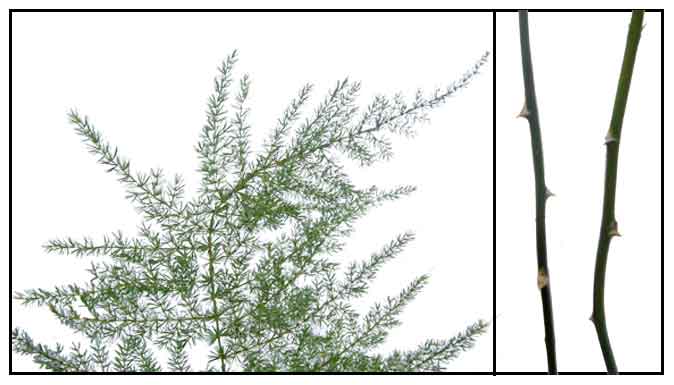| 
Gen
info
- Etymology: The specific name derives from Latin "saeta" meaning hair or bristle, originally described by the German botanist Carl Sigismund Kunth. The synonym A. plumosus derives from the Latin "plumed" referring to the foliage, as described by Bakerin 1875. (7)
-
Genus Asparagus of the
Liliaceae family is of medical importance because of its steroidal sapogenins
used as precursors for many pharmacologically active steroids.
- The common name is misleading as asparagus fern is not a fern at all.
Botany
Asparagus fern is a slender, climbing or
ascending, branched perennial, with round, green and wiry stems, with
very numerous slender branches and branchlets that spread horizontally, forming triangular
fernlike sprays, with the upper internodes 1 to 2 millimeters long. Leaves (cladodes) are setaceous, very slender, 3 to 5
millimeters long, ascending or spreading, 6 to 12 in a fascicle. Flowers are
small, perfect, solitary at the ends of the branches, with very short pedicels, about 1 millimeter long.
Perianth-segments are about 2 millimeters long and spreading. Fruit is a purple and black ovoid berry.
Distribution
- Cultivated for ornamental
use, usually as a garden or potted house plant.
- Used as ground cover.
- Recently introduced.
- Native of Africa.
- Cultivated in most warm countries.
- Considered an environmental weed in pasts of Australia; a serious weed in native bushland coastal environs, and rainforest communities.
(8)
Constituents
• Study of MeOH extract of eaves isolated
two new furostanol glycosides characterized as 3-O-[{α-L-rhamnopyranosyl(1->2)} {α-L-rhamnopyranosyl (1-->3)} -ß-D-glycopyransyl), 26-O-[ß-D-glucopyranosyl]-(25-S)-22α-methoxy-furost-5-en-3ß,25-diol (1), and its corresponding 22-hydroxy analog (2).
• Study of lipid-depleted enzyme preparations (acetone powders) from young shoots of A. plumosus efficiently catalyzed UDPG-dependent glucosylation of many 3ß-hydroxy steroids, including phytosterols, steroidal sapogenins of the spirostane type and some steroidal alkaloids structurally related to spirostanols. (10)
Properties
•Traditionally, antimalarial, diuretic.
- No reported serious toxicity; however, there are reported cases of mild contact dermatitis.

Uses
Edibility
- Young shoots reportedly edible.
Folkloric
- No reported folkloric medicinal use in the Philippines.
- Used as diuretic, antiepileptic, applied topically in skin diseases, treat urination, gynaecology and andrology problems, orally for dysentery and diarrhea treatment and treat pulmonary infections. (11)
- In Mexico
a decoction of the branches are used for pulmonary infections; decoction of roots used as a diuretic.
- In Tanzania, the Lobedu drink a cold infusion
of leaves and stem for malaria.
- In Pakistan, root tubers used with boiled milk and sugar for dysentery and diarrhea.
Others
- Ornamental: The cuts sprays of the
asparagus fern are ornamental favorites among florists for its beauty
and lasting quality.
Studies
• Phytochemicals / Glycosides: A methanolic extract study of leaves of A plumosus yielded two new furostanol glycosides (1) Study yielded three spirostanol glycosides from the leaves.
(2)
• Male Contraceptive Effect / Roots: 2-yamogenin and 2-furostanol glycosides isolated from the alcoholic extract of root caused 100% immobilization of human spermatozoa at 1% and 1.5%, levels respectively. (Pant G, Panwar MS, Negi DS, Zagorski M. Steroidal glycosides from Asparagus plumosus baker. Herba Polonica. 1988; 34:175-81) (9)
• Steroid-Specific Glucosyltransferases / Shoots: Study of lipid-depleted enzyme preparations (acetone powders) from young shoots of A. plumosus efficiently catalyzed UDPG-dependent glucosylation of many 3ß-hydroxy steroids, including phytosterols, steroidal sapogenins of the spirostane type and some steroidal alkaloids structurally related to spirostanols.
(10)
Availability
- Cultivated for ornamental use.
- Plant, seeds in the cybermarket.
|






